Each month, the NSF Current newsletter highlights research and education efforts supported by the National Science Foundation. If you would like to automatically receive notifications by e-mail or RSS when future editions of NSF Current are available, please use the links below:
![]() Subscribe to NSF Current by e-mail |
Subscribe to NSF Current by e-mail | ![]() What is RSS? |
What is RSS? | ![]() Print this page |
Print this page | ![]() Return to NSF Current Archive
Return to NSF Current Archive
Take a one-minute reader survey.
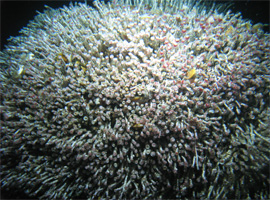
Scientists traveling to the ocean floor inside the deep-sea submersible ALVIN found a surprising new ecosystem--complete with marine creatures never before reported. The zone was dubbed a "hydrothermal seep" because two previously known ecosystems exist in a blended form: hydrothermal vents, where warm water surges from the seafloor, and cold areas where methane seeps from the ocean bottom.
In the hybrid ecosystem, found at a depth of almost 1800 meters (1.1 miles) at the margin of a tectonic plate off Costa Rica, marine life thrives in the total absence of sunlight. The scientists recorded a large "bush" 1.9 meters (almost 6 feet 3 inches) in diameter containing more than 14,000 tubeworms; dense beds of clams, mussels and limpets; and intriguing mixtures of microbes.
The use of ALVIN was key to discovering the hot-cold mixture at the site known as Jaco Scar, according to lead scientist Lisa Levin of Scripps Institution of Oceanography at University of California, San Diego. "The site had been visited by other researchers using remotely operated vehicles," said Levin, "but it wasn't until human eyes saw shimmering water flowing from under a tubeworm 'bush' that we really understood how special Jaco Scar is."
See the NSF press release for more information, photos and video. View additional video of the expedition here.
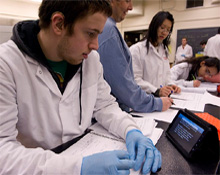
Deaf and hard-of-hearing college students now have an app for reading real-time, speech-to-text translations of their professors' instruction in science labs and at remote field sites. The smartphone technology has the potential to revolutionize learning and improve career opportunities for the 24,000 deaf U.S. undergraduates studying science, engineering and technology.
For decades, students have relied on costly sign language interpreters who struggle to learn complex science vocabularies. Due to advances in remote, real-time, speech-to-text translation, hearing professors and deaf students can now communicate more effectively--and less expensively--in both lab- and field-based settings. The smartphone app can be 25-50 percent less expensive than sign language interpretation, depending on location.
The breakthrough learning tool was created by a team from the Rochester Institute of Technology's National Technical Institute for the Deaf in New York with support from NSF. The app pairs C-PRINT®, a speech-to-text system developed by the Institute, with technology developed by Samsung, Verizon, Microsoft and Google. Find more information here.
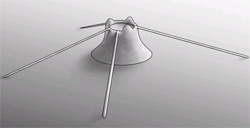
Fossils of the ancient organism Coronacollina acula, recently discovered in Australia, indicate it lived between 560 million and 550 million years ago, making it the oldest recorded animal with a skeleton. Shaped roughly like a thimble, it lived on the sea floor and had long, straight, needle-like appendages.
An NSF-supported team of paleontologists found hundreds of the fossilized casts. They believe the organism probably held itself up with the 20- to 40-centimeter-long "spicules" extending from its body. It may have ingested food in the same manner as a sponge--filtering water through its body--and was probably incapable of locomotion.
The finding by University of California, Riverside, scientists throws into question the previous understanding that animals were soft-bodied until the Cambrian Period, 542-488 million years ago, when Earth experienced a rapid diversification of life-forms and the rise of mineralized organisms. The spicules of the pre-Cambrian Coronacollina acula must have been mineralized, explained lead geologist Mary Droser, because they were ruler-straight, and some spicules had broken.
Droser noted that the finding is tremendously exciting because it represents "the first appearance of one of the major novelties of animal evolution." The name translates as "little rimmed hill with needles."
Click here for the full story.

As you head to the rink (or the couch) for the upcoming playoffs, consider this: Whether hockey players are sprinting down the ice, smashing into the boards or stopping on a dime, all of their amazing moves are governed by fundamental laws of physics.
NSF-funded astrophysicist Robert Gehrz, University of Minnesota, and Jim Gates, theoretical physicist at the University of Maryland, explain in this video how Newton's Three Laws of Motion are at work during every movement of the players and puck. The video is part of a 10-part Science of NHL Hockey series produced jointly by NSF, NBC Learn, NBC Sports and the National Hockey League.
Businesses rate trademarks, trade secrets and copyrights as the most important forms of intellectual property (IP) protection, according to recently published survey results.
Much of a business' competitive advantage lies in the ability to protect and exploit exclusive rights over investments in IP--creative outcomes lacking physical substance but providing long-term benefits to the company. The survey results from NSF and the U.S. Census Bureau show that businesses use a variety of IP-protection strategies tailored to their industries and the intangible assets they want to protect.
More U.S. businesses reported that trademarks (15 percent), trade secrets (14 percent) and copyrights (12 percent) were important forms of IP protection. Fewer reported that design patents (6 percent), utility patents (5 percent) and mask works (copyright protection for semiconductor products; 3 percent) were important. More information is available in this InfoBrief from NSF's National Center for Science and Engineering Statistics.

Research funded by NSF has resulted in innovations with a huge range of societal benefits--from advances in electronics to environmental cleanup to health monitoring. A briefing hosted by the Congressional Research & Development Caucus on March 29, 2012, highlighted several examples of fundamental research that led to marketable technologies. The event was co-sponsored by NSF and the non-profit Coalition for National Science Funding.
Members of Congress Daniel Lipinski (IL-3) and Sheila Jackson Lee (TX-18) joined NSF Director Subra Suresh in briefing more than 100 guests on the central role of fundamental science and engineering in developing products and processes with market potential. In turn, those innovations stimulate jobs and economic growth.
"For 60 years, NSF has played a central role in innovation by catalyzing the development of fundamental ideas in science," said Suresh. "NSF remains the nation's engine of innovation."
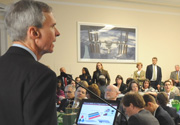
The Capitol Hill event featured:
- Richard Haber of the Ceramic, Composite, and Optical Materials Center at Rutgers University, an NSF Industry/University Cooperative Research Center that has developed military body armor and environmentally friendly concrete.
- Neil Kane, Illinois Partners, who mentors grantees in NSF's Innovation Corps program; researchers at the University of Illinois, Urbana-Champaign, are establishing a company to commercialize glucose-monitoring technology.
- Stephen Spoonamore of Ohio-based ABSMaterials, Inc., which used NSF Small Business Innovation Research (SBIR) grants to develop and produce Osorb®, a water-treatment technology.
- Charles Wessner, National Academy of Sciences, who emphasized the value of the SBIR program.
Three of the speakers also spoke at NSF the previous day; view a video here.
Early Spring Throwing Nature Out of Sync (Wall Street Journal) While warmer weather might bring relief from cold, biting winds, an NSF-funded scientist says it could be too much of a good thing.
New Frog Species in New York Was Croaking in Plain Sight (New York Times) A Rutgers ecologist and his colleagues determined an urban leopard frog was a new species, partly because of its unusual croak.
Coral Damage Linked to Deepwater Horizon Spill (CNN) A Penn State biologist, leading an NSF-funded expedition to gather data after the oil spill, reported damage to coral reefs deep beneath the surface.
White House Launches Big Data R&D Push (PCWorld) NSF is one of six government agencies that will spend more than $200 million to analyze large volumes of digital data generated by research.
NSF's Most Powerful Computing Resource Opens Doors (Scientific Computing) Six research teams began using the Blue Waters petascale supercomputer center to study complex problems, from HIV to climate change.

Scientists have observed the sun and moon from deep below the ground, using an extraordinarily sensitive detector in the Soudan Underground Lab in northern Minnesota. They observed the "shadow" the bodies cast in the cosmic rays passing through a half-mile of rock above the detector.
Particle physicists have long hoped to be able to "observe" objects and activity in the skies by detecting particles that reach the earth, such as cosmic rays. Before scientists can hope to detect emissions from new astrophysical sources, however, they are testing their capabilities by observing more mundane objects in our solar system, such as the sun and moon--still a considerable challenge for a deep underground lab.
High-energy particles called cosmic rays are rattling around our galaxy all the time. Those that reach the earth cause sprays of secondary particles when colliding with the upper atmosphere. Particle detectors studying rare phenomena such as neutrinos (subatomic particles) are often placed deep underground, where the rock shields out the majority of the cosmic-ray-induced particles. However, a few of the most energetic particles penetrate anyway, and these are recorded by detectors at the NSF-supported Main Injector Neutrino Oscillation Search (MINOS) experiment at Soudan. The MINOS experiment is designed primarily to observe highly elusive neutrinos and determine whether they have mass.
By making a map of the directions from which cosmic rays came over many years, the scientists observed a deficit in the directions of the sun and moon as those bodies blocked cosmic rays from entering our solar system. The scientists report on the observations here.
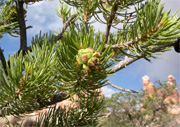
A growing body of research shows that birds and other animals change their behavior in response to human noise, such as the din of traffic or the hum of machinery. But human clamor doesn't just affect animals.
Because many animals also pollinate plants or eat or disperse their seeds, human noise can have a ripple effect on plants, too. A team of scientists led by Clinton Francis of an NSF-funded research center in Durham, N.C., conducted experiments from 2007 to 2010 in the Rattlesnake Canyon Wildlife Area in New Mexico. The area is home to noisy compressors located at natural gas wells.
The researchers measured visits by pollinators, such as the black-chinned hummingbird, and scatterers of piñon pine seeds, such as mice and scrub jays. They found, surprisingly, that pollen transfer was more common at noisy sites--but that piñon pine populations could suffer from fewer seeds dropped in those areas.
In cases where noise has ripple effects on long-lived plants like trees, the consequences could last for decades, even after the source of the noise goes away, said Francis. For more information and photos, see the NSF press release.



